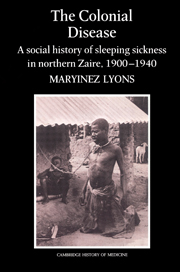Book contents
- Frontmatter
- Contents
- List of maps
- List of plates
- List of tables
- Preface
- List of abbreviations
- Map 1 Africa: political
- 1 Disease and medicine in the history of Africa
- 2 From private empire to public colony
- 3 Mise en valeur: economic exploitation
- 4 Epidemiology and ecology of human sleeping sickness
- 5 ‘The Lure of the Exotic’: sleeping sickness, tropical medicine and imperialism
- 6 Discovery: Liverpool scientists in the Congo
- 7 The campaign. Part one: sleeping sickness and social medicine
- 8 The campaign. Part two: the surveys and tensions
- 9 The African response
- 10 Public health, social engineering and African lives
- 11 Conclusion and legacy
- Appendices
- Notes
- Select bibliography
- Index
10 - Public health, social engineering and African lives
Published online by Cambridge University Press: 06 January 2010
- Frontmatter
- Contents
- List of maps
- List of plates
- List of tables
- Preface
- List of abbreviations
- Map 1 Africa: political
- 1 Disease and medicine in the history of Africa
- 2 From private empire to public colony
- 3 Mise en valeur: economic exploitation
- 4 Epidemiology and ecology of human sleeping sickness
- 5 ‘The Lure of the Exotic’: sleeping sickness, tropical medicine and imperialism
- 6 Discovery: Liverpool scientists in the Congo
- 7 The campaign. Part one: sleeping sickness and social medicine
- 8 The campaign. Part two: the surveys and tensions
- 9 The African response
- 10 Public health, social engineering and African lives
- 11 Conclusion and legacy
- Appendices
- Notes
- Select bibliography
- Index
Summary
The safest place for the fly is on the flyswatter.
G. LichtenbergBelgian public health policy was eminently spatial in concept. As has been shown previously, a principal feature of the sleeping sickness campaign was the cordon sanitaire. The Belgians hoped eventually to sterilise the total human reservoir of the disease-causing pathogens, but until such time it was necessary to enforce a strict line of defence around the still uninfected portions of the colony. The health of the African population would be monitored and protected by dividing the entire colony into a pattern of zones designated as either ‘infected’ or ‘noninfected’ by sleeping sickness. A complex set of regulatory measures was produced to control the movements of people among the zones, with particular emphasis on limiting access to non-infected areas, as much of the Uele district was presumed to be. Such a global public health policy, focused on limiting movement, affected every sphere of African life – social, political and economic.
Most Congolese, however, perceived the sleeping sickness policy as simply another feature of foreign domination. Before 1930 the majority of northern Congolese would have had considerable difficulty distinguishing between medical and all other economic and political regulations imposed by the state. Most people were bewildered by the web of administrative edicts and many often found themselves caught in the dilemma of being forced by demands of one colonial department to break the rules of another department. The life of a Congolese was made no easier by public health measures intended to protect him from disease.
- Type
- Chapter
- Information
- The Colonial DiseaseA Social History of Sleeping Sickness in Northern Zaire, 1900–1940, pp. 199 - 222Publisher: Cambridge University PressPrint publication year: 1992



